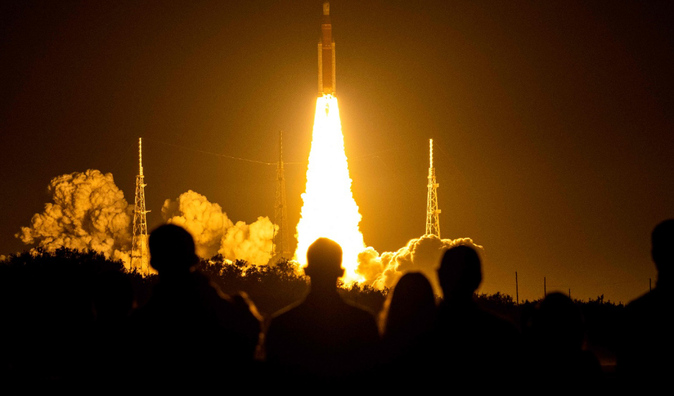The world's most powerful rocket , NASA
's
Space Launch System
(
SLS
) , successfully propelled the
Orion
spacecraft
to the Moon on Wednesday, but caused some damage to the launch pad at the Kennedy Space Center (Florida) during the takeoff of
Artemis 1,
a 25-day
unmanned
mission with which NASA has kicked off its program to return to our satellite.
During the press conference offered from the Johnson Space Center in Houston to report on the progress of Artemis 1 after completing the closest approach of the
Orion
spacecraft to the lunar surface, from which it was 130 kilometers away, Mike Sarafin, head of the mission, noted that the high power of the rocket had damaged the elevator doors of Launch Pad 39B.
The 98-meter SLS rocket caused more damage than expected on the launch pad at the Kennedy Space Center.
The thrust force of the takeoff was so enormous that it
ripped the armored doors off the elevators,
rendering them unusable.
Mike Sarafin assured that the damage to the platform will be repaired in sufficient time so that it does not affect the next launch of Artemis 2, scheduled for 2024. During the Apollo program, the Saturn V super rockets were used.
Frame of the elevators without doors after takeoffNASA
After launch, they found two small flight components near the pad that shouldn't have been there.
A small piece ("throat plug material") that rockets occasionally detach during takeoffs, according to Sarafin, and a fragment of RTV (the putty-like material used to protect the Orion spacecraft). .
"It's not clear if the RTV piece came loose from Hurricane [Denise] or during liftoff," Sarafin admitted.
He also described some minor damage to the system of "pneumatic lines associated with gaseous nitrogen and gaseous helium" that services the huge tanks of the SLS rocket.
This is the first time that NASA has flight tested all the systems of the SLS and the Orion spacecraft.
As he pointed out in an appearance three days after takeoff, the person in charge of NASA assured that the progress of the mission is exceeding his expectations, he highly valued the behavior of the SLS rocket on its debut.
NASA engineers also noted that the maneuvers have consumed less propellant fuel than they had anticipated before launch.
To know more
Space.
NASA Artemis 1 Mission: The Orion spacecraft approaches 130 km from the Moon and flies over the landing sites of the Apollo spacecraft
Writing: TERESA GUERREROMadrid
NASA Artemis 1 Mission: The Orion spacecraft approaches 130 km from the Moon and flies over the landing sites of the Apollo spacecraft
Space.
Launch of Artemis 1: the new lunar race takes off but the US is now competing with China
Writing: TERESA GUERREROMadrid
Launch of Artemis 1: the new lunar race takes off but the US is now competing with China
"The mission continues to progress as planned, and the ground systems, our operations teams and the
Orion
spacecraft continue to exceed expectations, and we continue to learn along the way about this new deep-space spacecraft," Sarafin said. they would make some changes for Artemis 2. The person in charge of NASA indicated that they are looking for solutions for some problems that they have detected, such as one related to the star trackers of the navigation system and another to the energy system.
"It's about making it as safe as possible, given the hostile environment that our astronauts are going to be flying in."
The 'Orion' capsule successfully approaching 130 kilometers from the Moon.NASA
Since it took off a week ago
, the spacecraft has traveled about 350,000 kilometers.
On Friday the
Orion
spacecraft will make new maneuvers to enter the so-called
distant retrograde orbit,
and if everything goes according to plan, it will re-enter the Earth's atmosphere on December 11, when it will have to splash down in the Pacific.
The next mission, Artemis 2, is scheduled for 2024 and although it will go with astronauts, it will not land on the Moon.
The moon landing with astronauts is scheduled for Artemis 3, in 2025.
According to the criteria of The Trust Project
Know more
POT

